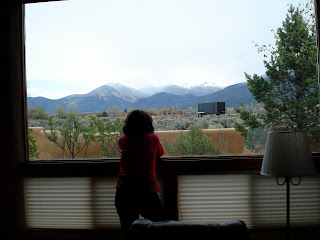As we are growing up, we learn what the right ways to think, feel, and act from the people close to us. For me, that usually meant that I did or said something that got me in trouble. For example, my brother and I were throwing our little sister into a pile of leaves. All of us were laughing. My dad came out and saw us and started to holler. I was so shocked I started to cry until my shoulders heaved and I could hardly catch my breath. Note to self: Don't throw siblings into the leaves.
I wondered why they didn't just tell me all the rules up front and be done with it. Why did I have to be surprised, even shocked, that something I was enjoying was against the rules?
That's the thing about culture: It goes without saying. Mostly what anthropologists look at, then, are called the artifacts--the clothes, language, art, objects, tools, and so forth.
For example, in my family Easter photo, the girls' hats, the boys' ties, my corsage, and the fact that our picture was taken at all, are all visible symbols that this was a special day. In terms of Luthans and Doh's Model of Culture (see below), our clothes and the other ways we celebrated Easter are "the explicit artifacts and products of the society" in which I grew up.
Image from Luthans and Doh (2012, p. 110)
The inner-most circle represents the implicit, basic assumptions that guide people's behavior. While many of our basic assumptions that guided our behavior came from our religion, others came from being of Irish heritage, from growing up in the USA at the time, and so forth. For example, as a young child, I liked my cowgirl outfit.
Culture, therefore, is a hidden influence on motivation. And sometimes the land, the shape of the Earth where we find ourselves, influences culture. For example, and speaking of cowboys, the idea that there is more land beyond the frontier has been said to influence how we Americans ARE.
"The presence and predominance of numerous cultural traits -- "that coarseness and strength combined with acuteness and acquisitiveness; that practical inventive turn of mind, quick to find expedients; that masterful grasp of material things... that restless, nervous energy; that dominant individualism" -- could all be attributed to the influence of the frontier." (http://www.pbs.org/weta/thewest/people/s_z/turner.htm)
This last photo was taken outside of Taos New Mexico, whose desert land provides stunning vistas of the horizon and nearby mountains.
Speaking of Easter, and of culture, I laughed out loud upon hearing a book on tape called Me Talk Pretty Some Day by David Sedaris. The first link is to a summary of Sedaris' work created for CI 403 Section E for Dr. Arlette Ingram Willis' class at the University of Illinois at Urbana-Champaign.. http://students.ed.uiuc.edu/dashton2/autobiographywebpage/storysummaries.html. The essay about Easter is entitled Jesus Shaves, and is the story about David and his international classmates in a French language class in Paris trying to use their very limited French to explain Easter to their Moroccan classmate:
Despite her having grown up in a Muslim country, it seemed she might have heard it mentioned once or twice, but no. "I mean it," she said. "I have no idea what you people are talking about."
The teacher then called upon the rest of us to explain.
The Poles led the charge to the best of their ability. "It is," said one, "a party for the little boy of God who call his self Jesus and . . . oh, s---."
She faltered, and her fellow countryman came to her aid. "He call his self Jesus, and then he be die one day on two . . . morsels of . . . lumber."The rest of the class jumped in, offering bits of information that would have given the pope an aneurysm.
"He die one day, and then he go above of my head to live with your father."
"He weared the long hair, and after he died, the first day he come back here for to say hello to the peoples."
"He nice, the Jesus."
"He make the good things, and on the Easter we be sad because somebody makes him dead today."
Part of the problem had to do with grammar. Simple nouns such as cross and resurrection were beyond our grasp, let alone such complicated reflexive phrases as "To give of yourself your only begotten son." Faced with the challenge of explaining the cornerstone of Christianity, we did what any self-respecting group of people might do. We talked about food instead.
"Easter is a party for to eat of the lamb," the Italian nanny explained. "One, too, may eat of the chocolate."
"And who brings the chocolate?" the teacher asked.
I knew the word, and so I raised my hand, saying, "The Rabbit of Easter. He bring of the chocolate."
My classmates reacted as though I'd attributed the delivery to the Antichrist. They were mortified.
"A rabbit?" The teacher, assuming I'd used the wrong word, positioned her index fingers on top of her head, wiggling them as though they were ears. "You mean one of these? A rabbit rabbit?"
"Well, sure," I said. "He come in the night when one sleep on a bed. With a hand he have the basket and foods."
The teacher sadly shook her head, as if this explained everything that was wrong with my country. "No, no," she said. "Here in France the chocolate is brought by the big bell that flies in from Rome."



No comments:
Post a Comment